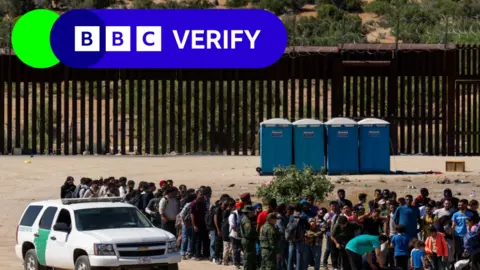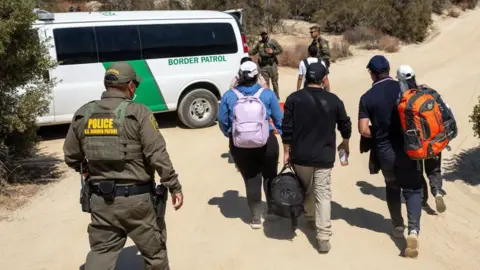How many migrants have crossed the US border illegally?
 Getty Images
Getty ImagesCracking down on illegal immigration has been Donald Trump’s signature issue - but now Democrats are trying to address an election weakness by also talking tough about securing the US border with Mexico.
The Republican presidential nominee has repeatedly criticised the government's record on the border, claiming - without providing evidence - that "Kamala Harris has allowed 21 million illegals to pour in from all over the world.”
Crossings did reach record levels under President Biden, but numbers have dropped significantly in recent months. Now Harris says she will make it even harder for migrants to seek asylum in the US.
Six out of 10 Americans rate immigration as “very important” in determining how they will vote, according to the Pew Research Center. Other polling suggests voters trust Trump to handle the issue more effectively than Harris.
So how have both administrations dealt with the influx of migrants and what do we know about the people crossing this border illegally?
How many migrants have crossed the US southern border?
US border officials record "encounters" with migrants - these include people who attempted to cross illegally and people who tried to enter legally but were deemed inadmissible.
These encounters have risen to record highs under the Biden administration but not to the level Trump - who has not provided a source for his claim - maintains.
Since January 2021, when Joe Biden came to office, there have been more than 10 million encounters - about 8 million came over the southwest land border with Mexico.
Under the Trump administration, there were 2.4 million encounters on this border.
Encounters fell at the start of 2020 as arrivals slowed because of the pandemic.
The number of encounters is not a count of individuals who stay in the US as some migrants will be returned and the same person can be recorded trying to enter multiple times.
These figures don't include people who may have crossed the border undetected.
The US Department of Homeland Security has estimated there were 11 million illegal migrants living in the US as of January 2022.
It says about a fifth of them arrived in 2010 or later but the majority arrived before this time, some as early as the 1980s.
How have government policies affected border crossings?
Both the Trump and Biden administrations used a Covid-19 public health measure to quickly return migrants at the border.
Between its start in March 2020 and its end in May 2023, migrants were expelled nearly three million times under this policy.
Despite this, encounters continued to increase, according to the Migration Policy Institute.
The factors driving this included a post-lockdown surge in crossings and political and economic instability in countries such as Venezuela.
Republicans say Biden’s “weak” policies on immigration also encouraged migrants to travel to the US - and some Democrats in border states criticised the administration for not acting quickly enough to address the crisis.
An attempt to pass a cross-party bill to tighten border security failed in May 2024, with Harris saying that Trump "tanked it".
Biden issued an executive order the following month to quickly deport migrants at the border.
This means migrants can be sent back without having their asylum claims processed, if the average number of weekly encounters exceeded a certain threshold.
A month after the order was introduced, encounters at the southern border fell by a fifth.
Efforts by the Mexican government have also brought crossings down, including setting up new checkpoints and increasing patrols.
In May, Mexican President Andrés Manuel López Obrador said that the number of migrants at the US southern border had halved from a peak of 12,000 a day to 6,000 a day.
Where are the migrants coming from?
The vast majority of people who cross the US southern border are citizens of nearby countries in the Americas.
Recent figures show that in the current financial year (October 2023 - September 2024), the most common nationality encountered at the southern border were Mexicans (617,770).
This was followed by nearly a quarter of a million Venezuelans and almost 200,000 Guatemalans.
There have also been 36,920 encounters of Chinese citizens this financial year to date.
That's 10,000 higher than for the whole of the previous financial year.

How many border migrants have criminal records?
Trump has repeatedly said about illegal migrants that "many of them that are coming in are from prisons and jails and mental institutions, insane asylums".
There are no publicly available figures on how many border migrants have spent time in prison or in mental institutions but there is data on how many have previous criminal convictions.
Of the 1.5 million apprehensions of people crossing the border illegally so far this financial year - and where Border Patrol was able to check against law enforcement databases - about 15,608 were of people with previous criminal convictions.
The most common conviction was for illegal entry into another country (9,545), followed by driving under the influence (2,577), and drug possession and trafficking offences (1,414).
US Immigration and Customs Enforcement (ICE) recently released figures showing that, as of July 2024, there were 435,719 non-citizens with criminal convictions on its database.
The data goes back decades, including individuals who entered the US over the past 40 years. It includes people detained by ICE and people detained elsewhere, such as in prison or under the supervision of other agencies.
It does not say how the people in the database entered the country or whether they did so illegally.
Trump has also linked border crossings with fuelling violent crime in the US. At campaign events he has spoken about alleged killings of American women by undocumented migrants.
But crime and migration trends have travelled in opposite directions in recent years.
Department of Justice figures show a long-term decline in violent crime, with rates of victimisation in 2023 broadly similar to five years ago. Recent FBI data also indicates a downward trend in violence.
 Getty Images
Getty ImagesIs Venezuela emptying its prisons into the US?
Trump also claims that Venezuela has been sending its prisoners into the US.
In July he said: “Next year we’ll meet in Venezuela because it will be safe. Their crime has gone down 72% because they’ve sent all of their drug dealers, their criminals and most of their prisoners into our country.”
BBC Verify spoke to the independent Venezuelan Observatory of Violence.
It said it had seen no evidence that the Venezuelan government has been systematically sending its prisoners to the US or to any other country.
The Observatory's figures show crime has fallen in Venezuela in the past few years, but not to the extent Trump has claimed and for other reasons.
"Crime is reduced in Venezuela by a reduction in crime opportunities: bank robberies disappear because there is no money to steal; kidnappings are reduced because there is no cash to pay ransoms; robberies on public transport cease because travellers have no money in their pockets and old, worthless cell phones," a spokesperson from the Observatory said.
 Getty Images
Getty Images
